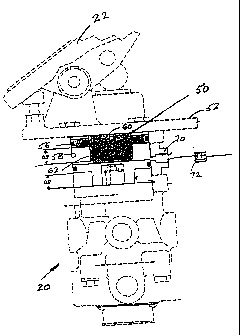Some of the information on this Web page has been provided by external sources. The Government of Canada is not responsible for the accuracy, reliability or currency of the information supplied by external sources. Users wishing to rely upon this information should consult directly with the source of the information. Content provided by external sources is not subject to official languages, privacy and accessibility requirements.
Any discrepancies in the text and image of the Claims and Abstract are due to differing posting times. Text of the Claims and Abstract are posted:
| (12) Patent: | (11) CA 2430961 |
|---|---|
| (54) English Title: | INTEGRATED FOOT CONTROL VALVE ACTUATOR |
| (54) French Title: | ACTIONNEUR DE SOUPAPE DE COMMANDE AU PIED INTEGRE |
| Status: | Term Expired - Post Grant Beyond Limit |
| (51) International Patent Classification (IPC): |
|
|---|---|
| (72) Inventors : |
|
| (73) Owners : |
|
| (71) Applicants : |
|
| (74) Agent: | MACRAE & CO. |
| (74) Associate agent: | |
| (45) Issued: | 2011-02-01 |
| (86) PCT Filing Date: | 2001-12-04 |
| (87) Open to Public Inspection: | 2002-08-01 |
| Examination requested: | 2006-10-23 |
| Availability of licence: | N/A |
| Dedicated to the Public: | N/A |
| (25) Language of filing: | English |
| Patent Cooperation Treaty (PCT): | Yes |
|---|---|
| (86) PCT Filing Number: | PCT/US2001/047413 |
| (87) International Publication Number: | US2001047413 |
| (85) National Entry: | 2003-06-03 |
| (30) Application Priority Data: | ||||||
|---|---|---|---|---|---|---|
|
A pneumatic actuator (50) is integrated into a foot control valve(20). It
includes a pneumatically activated piston that applies a force to the foot
control valve primary piston (32) which, in turn, applies the vehicle brake
system. The piston is configured to allow the pedal or treadle actuated
plunger (54) to push through the pneumatic actuator and apply the brake
system. This finds particular use as an add-on feature for pre-trip inspection
systems, as a working brake system, etc.
Selon l'invention, un actionneur pneumatique est intégré dans une soupape de commande au pied. Ledit actionneur comporte un piston activé de manière pneumatique, appliquant une force au piston primaire de la soupape de commande au pied, actionnant à son tour le système de freinage du véhicule. Ledit piston est configuré de manière que le plongeur actionné par pédale pousse l'actionneur pneumatique et actionne le système de freinage. L'actionneur selon l'invention peut notamment être employé en tant qu'équipement additionnel pour contrôle avant départ, par ex. pour le contrôle des freins.
Note: Claims are shown in the official language in which they were submitted.
Note: Descriptions are shown in the official language in which they were submitted.

2024-08-01:As part of the Next Generation Patents (NGP) transition, the Canadian Patents Database (CPD) now contains a more detailed Event History, which replicates the Event Log of our new back-office solution.
Please note that "Inactive:" events refers to events no longer in use in our new back-office solution.
For a clearer understanding of the status of the application/patent presented on this page, the site Disclaimer , as well as the definitions for Patent , Event History , Maintenance Fee and Payment History should be consulted.
| Description | Date |
|---|---|
| Inactive: Expired (new Act pat) | 2021-12-06 |
| Common Representative Appointed | 2019-10-30 |
| Common Representative Appointed | 2019-10-30 |
| Grant by Issuance | 2011-02-01 |
| Inactive: Cover page published | 2011-01-31 |
| Inactive: Final fee received | 2010-10-26 |
| Pre-grant | 2010-10-26 |
| Notice of Allowance is Issued | 2010-05-17 |
| Letter Sent | 2010-05-17 |
| Notice of Allowance is Issued | 2010-05-17 |
| Inactive: Approved for allowance (AFA) | 2010-05-13 |
| Amendment Received - Voluntary Amendment | 2010-01-07 |
| Inactive: S.30(2) Rules - Examiner requisition | 2009-12-10 |
| Letter Sent | 2009-07-17 |
| Amendment Received - Voluntary Amendment | 2009-06-10 |
| Reinstatement Requirements Deemed Compliant for All Abandonment Reasons | 2009-06-10 |
| Reinstatement Request Received | 2009-06-10 |
| Inactive: Abandoned - No reply to s.30(2) Rules requisition | 2009-02-23 |
| Inactive: S.30(2) Rules - Examiner requisition | 2008-08-22 |
| Letter Sent | 2006-11-08 |
| Request for Examination Requirements Determined Compliant | 2006-10-23 |
| Request for Examination Received | 2006-10-23 |
| All Requirements for Examination Determined Compliant | 2006-10-23 |
| Amendment Received - Voluntary Amendment | 2006-10-23 |
| Inactive: Correspondence - Transfer | 2004-06-15 |
| Inactive: Office letter | 2004-02-19 |
| Letter Sent | 2004-02-19 |
| Inactive: Multiple transfers | 2004-01-26 |
| Inactive: Cover page published | 2003-07-30 |
| Inactive: Courtesy letter - Evidence | 2003-07-29 |
| Inactive: Notice - National entry - No RFE | 2003-07-28 |
| Application Received - PCT | 2003-07-08 |
| National Entry Requirements Determined Compliant | 2003-06-03 |
| Application Published (Open to Public Inspection) | 2002-08-01 |
| Inactive: Single transfer | 2002-06-17 |
| Abandonment Date | Reason | Reinstatement Date |
|---|---|---|
| 2009-06-10 |
The last payment was received on 2010-11-15
Note : If the full payment has not been received on or before the date indicated, a further fee may be required which may be one of the following
Patent fees are adjusted on the 1st of January every year. The amounts above are the current amounts if received by December 31 of the current year.
Please refer to the CIPO
Patent Fees
web page to see all current fee amounts.
Note: Records showing the ownership history in alphabetical order.
| Current Owners on Record |
|---|
| BENDIX COMMERCIAL VEHICLE SYSTEMS LLC |
| Past Owners on Record |
|---|
| DAVID J. GOODELL |